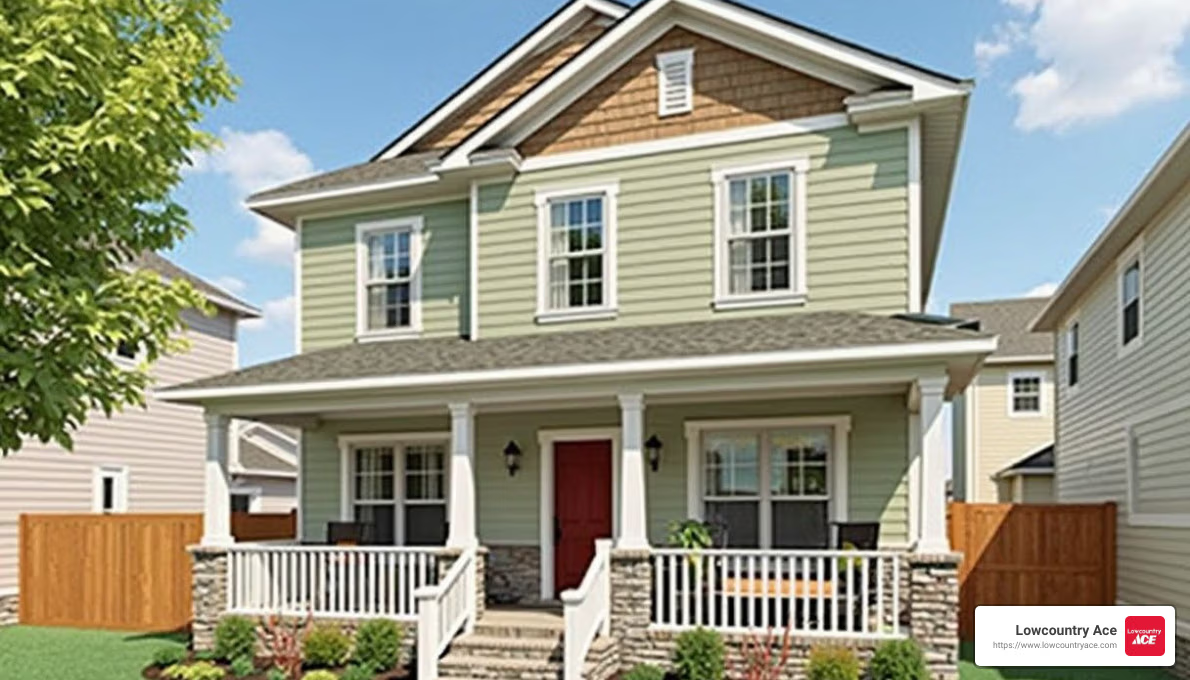DIY Home Addition Calculator: Top 5 Proven Tips 2024
When you’re thinking about expanding your home’s living space, a diy home addition calculator can be your best friend in navigating the financial landscape of home improvements.
Quick Steps to Get Started:
1. Measure your current home space and decide where to add.
2. Use a diy home addition calculator to get a cost estimate.
3. Plan your budget, considering materials, labor, and unexpected expenses.
4. Assess potential ROI (Return on Investment) for future value.
Planning a home addition involves careful cost estimation and budgeting. Whether you’re adding a room, an entire floor, or just expanding the living area, it’s crucial to understand the full financial picture before you begin. Evaluating the scope of your project and understanding material and labor costs can lead to better financial planning and avoid stress down the road.
At the helpful team at Lowcountry Ace, our mission is to empower homeowners with the knowledge and tools they need to successfully expand their homes. With experience in marketing and strategic planning, we provide expert advice and practical solutions to make your home addition projects both affordable and efficient.
Common diy home addition calculator vocab:
– DIY home improvement
– diy home addition
– diy home addition cost
Understanding Home Addition Costs
Planning a home addition is a big task. It’s not just about adding more space; it’s about making smart choices that fit your budget and needs. Let’s break down the key factors that impact the cost of a home addition.
Size and Scope
The size of your addition is a major cost driver. Bigger projects require more materials and labor, which means higher costs. For example, a simple 100-square-foot room addition might cost between $12,500 and $25,000, while a larger 400-square-foot addition could range from $50,000 to $100,000. The complexity of your project also matters. Adding a bathroom involves plumbing, which can increase costs compared to a simple bedroom addition.
Materials and Labor
Materials come in two main categories: basic and high-end. Basic materials like standard lumber and drywall are cost-effective, whereas high-end options like hardwood flooring or custom cabinetry can significantly increase your budget. For instance, high-end roofing materials might cost about $7 per square foot, adding up quickly over a large area.
Labor costs are another major expense, often making up 50% to 60% of the total project cost. Hiring a general contractor can streamline the process, but it adds to the expense. Labor rates vary widely, with electricians charging between $50 and $150 per hour and plumbers between $45 and $200 per hour.
Location and Room Type
The location of your addition affects costs too. Local permit fees and climate-specific requirements can add to your budget. For example, building in a cold climate may require additional insulation, raising costs. The type of room also plays a role. Kitchens and bathrooms are typically more expensive due to plumbing and electrical needs.
Finish Quality, Lighting, Windows, and Doors
The finish quality of your addition influences both cost and appearance. High-quality finishes last longer and look better, but they come at a higher price. Lighting is essential for creating a welcoming space. Plan for both natural and artificial lighting to improve the ambiance. Energy-efficient fixtures can save money in the long run.
Windows and doors are crucial for energy efficiency and aesthetics. Choose options that offer good insulation and match your home’s style.
Heating & Cooling, Purpose, Flooring, and Electrical
Extending your heating and cooling system ensures comfort in your new space. This might involve upgrading your HVAC system, which can be costly. The purpose of the addition guides many design decisions. A home office might need more electrical outlets, while a sunroom might focus on maximizing natural light.
Flooring should be durable and match the rest of the home. Options range from budget-friendly laminate to high-end hardwood. Electrical planning is vital for safety and functionality. Ensure there are enough outlets and consider energy-efficient lighting options.
Understanding these factors will help you make informed decisions and stay within your budget. Next, we’ll explore how to use a diy home addition calculator to estimate costs and plan your project effectively.
Using a DIY Home Addition Cost Calculator
Planning a home addition can feel like a puzzle, but we’ve got a tool to help you put the pieces together: the DIY home addition calculator. This calculator simplifies cost estimation, helping you budget effectively. Let’s explore the key inputs you’ll need and how to calculate return on investment (ROI).
Key Inputs for Accurate Estimates
To get the most out of a DIY home addition calculator, you’ll need to feed it some crucial information:
-
Current Square Footage: Start by entering the existing size of your home. This helps the calculator understand the scale of your project.
-
Desired Addition Size: Specify how large you want your addition to be. Whether it’s a cozy 200-square-foot office or a sprawling 600-square-foot family room, this detail is essential.
-
Home Value: Know your home’s current market value. Tools like Zillow can help you find this number. It serves as a baseline for calculating potential value increases.
With these inputs, the calculator provides an estimated cost range, factoring in typical expenses like materials and labor.
Calculating ROI
Understanding the ROI of your home addition is key to making informed financial decisions. Here’s how to approach it:
-
Current Home Value: This is your starting point. Knowing how much your home is worth before the addition sets the stage for assessing value changes.
-
Estimated Project Cost: Use the calculator to determine how much the addition will cost. This includes materials, labor, and any additional expenses.
-
Potential Value Increase: Different types of additions can boost your home’s value by varying amounts. For instance, adding a family room might significantly increase market value.
ROI Formula:
[ \text{ROI} = \left( \frac{\text{Potential Value Increase} – \text{Estimated Project Cost}}{\text{Estimated Project Cost}} \right) \times 100 ]
For example, if your home is currently valued at $300,000 and you add a $50,000 family room that increases the home’s value by $75,000, the ROI would be 50%.
Using a DIY home addition calculator not only helps in estimating costs but also in evaluating the financial benefits of your project. By understanding these aspects, you can proceed with confidence in your home addition plans.
Next, we’ll dig into the detailed cost breakdown, covering material costs, labor costs, and additional expenses.
Detailed Cost Breakdown
When planning a home addition, understanding the detailed cost breakdown is crucial. Let’s explore the primary components: material costs, labor costs, and additional expenses.
Material Costs
Materials make up a significant portion of your home addition budget. Here’s what to consider:
-
Basic Materials: These include essentials like lumber, drywall, and basic fixtures. For instance, the cost of lumber for a second-story addition might reach around $33,000. Basic materials are more affordable but may lack the durability or appeal of premium options.
-
High-End Materials: If you choose luxury materials, expect higher costs. High-end finishes, such as hardwood flooring or custom cabinetry, can significantly boost your budget. For example, roofing materials can cost about $7 per square foot, while siding might be around $5.50 per square foot.
-
Fixtures: Don’t overlook fixtures like plumbing and lighting. Plumbing fixtures can cost approximately $3,200, and lighting fixtures might add another $3,100 to your expenses.
Labor Costs
Labor is another major expense in your home addition project. It includes several stages:
-
Setup and Preparation: This involves site setup, preparation, and planning. Costs can vary depending on the complexity of the project.
-
Job Completion: This includes the actual construction work. Labor costs can range from 30% to 60% of the total project cost, covering everything from carpenters to electricians.
-
Cleanup: Post-construction cleanup is essential to ensure a safe and tidy space. This phase covers trash removal and site cleanup.
Additional Expenses
Several additional expenses can impact your overall budget:
-
Permits: Building permits are necessary for any home addition. Budget an extra $1,000 to $2,000 depending on the scope of your project and local regulations.
-
Taxes: You may need to account for taxes on labor and materials. While tax breaks are rare for home additions, energy-efficient upgrades might qualify for deductions.
-
HVAC, Electrical, and Plumbing: These systems are crucial for a functional addition. For example, rough-in plumbing can cost around $5,700, and electrical wiring might be $0.70 per square foot. Don’t forget to consider HVAC adjustments for climate control.
By examining these cost components, you can create a comprehensive budget for your home addition. Understanding each element helps you manage expenses and make informed decisions.
Next, we’ll explore real-world examples and case studies to provide further insights into home addition projects.
Real-World Examples and Case Studies
When considering a home addition, it’s helpful to look at real-world examples to understand what different projects might entail. Let’s explore small, medium, and large additions, along with some detailed case studies.
Small Additions
Small additions typically range from 100 to 200 square feet. These projects are perfect for adding a cozy home office, a small bedroom, or a modest bathroom.
For instance, a family in Charleston, SC, added a 150-square-foot home office. This project, which included custom built-in shelves and high-end finishes, cost $30,000. The result was a significant increase in the home’s functionality and a moderate rise in property value.
Medium Additions
Medium-sized additions range from 200 to 600 square feet and often involve expanding existing spaces. This could mean enlarging your kitchen, adding a family room, or creating a master suite.
A great example is a 400-square-foot family room addition in Mount Pleasant, SC. The homeowner included large windows for natural light and a fireplace, making it a warm and inviting space. The total cost of this project was $85,000, and the new room quickly became the heart of the home for family gatherings.
Large Additions
Large additions, spanning 600 to 1000+ square feet, can dramatically transform a home. These projects might include adding a second story, multiple rooms, or an in-law suite.
In Summerville, SC, a home underwent a major change with an 800-square-foot second story addition. The project included two bedrooms, a bathroom, and a small living area, costing $200,000. This addition not only increased the living space but also significantly boosted the property’s value.
Case Studies
These case studies highlight how different sizes and types of additions can vary in cost and function. They illustrate the potential impact on both the livability and value of a home. Whether you’re considering a small home office or a large second story, understanding these examples can help guide your decision-making process.
By examining these real-world projects, you can better envision how a home addition might fit into your plans and what it might cost. Next, we’ll address some frequently asked questions about home addition costs to further clarify your planning process.
Frequently Asked Questions about Home Addition Costs
Adding a home addition can be a big decision, and it’s normal to have questions about costs. Let’s explore some of the most common queries people have:
How much does it cost to add 1000 square feet to a house?
Adding 1000 square feet to a house is a significant project that can cost between $125,000 and $250,000. The wide range is influenced by factors like:
- Materials and Finishes: Using basic materials will keep costs on the lower end, while high-end finishes can push costs higher.
- Labor Costs: These can vary greatly depending on your location and the complexity of the work involved.
- Room Type: Simple living areas are cheaper than kitchens or bathrooms, which require plumbing and electrical work.
How do you calculate the cost of a home addition?
Calculating the cost of a home addition involves several steps:
- Determine Square Footage: Measure the area you plan to add.
- Estimate Cost Per Square Foot: Use local averages. In many areas, this is around $300 to $350 per square foot.
- Add Material and Labor Costs: Start with basic materials and labor. High-end options will increase this base cost.
- Include Additional Expenses: Consider permits, taxes, and potential upgrades to systems like HVAC or electrical.
Example Calculation:
For a 200-square-foot addition at $300 per square foot:
[ 200 \text{ SF} \times \$300/\text{SF} = \$60,000 ]
How much does it cost to add a 24×24 room?
A 24×24 room, which is 576 square feet, can cost between $144,000 and $288,000. Key factors that influence this cost include:
- Material Quality: Basic versus premium materials can create a big difference in cost.
- Room Purpose: A simple bedroom will cost less than a kitchen or bathroom.
- Location: Costs can vary significantly depending on your region.
By understanding these factors and using a DIY home addition calculator, you can better estimate and plan your budget for a home addition.
Whether you’re considering a small bump-out or a large-scale second story, these FAQs should provide a clearer picture of what to expect in terms of costs. Now that we’ve covered the basics, let’s move on to the conclusion where we’ll discuss how Lowcountry Ace can assist you in your home addition journey.
Conclusion
Planning a home addition is a big step, and having the right support can make all the difference. At Lowcountry Ace Hardware, we are dedicated to being more than just a supplier; we’re your partner in making your home addition dreams a reality.
Budgeting and Planning
Effective planning and budgeting are crucial for any home addition project. By using a DIY home addition calculator, you can get a clearer picture of the costs involved, helping you make informed decisions. Every project is unique, and factors like materials, labor, and location can significantly influence costs. Our team is here to guide you through this process, ensuring you have all the information you need to plan effectively.
Customer Service
We pride ourselves on our exceptional customer service. Our knowledgeable staff is always ready to provide expert advice and answer any questions you may have about your project. Whether you’re a seasoned DIY enthusiast or new to home improvement, we’re here to support you every step of the way.
Local Convenience
Conveniently located at the Riverland Market on Folly Road, Lowcountry Ace serves the James Island and Folly Beach areas. We offer a wide range of products and services, including home delivery, to meet all your home addition needs. By choosing us, you’re not just purchasing supplies; you’re supporting a local business that values community and quality service.
For more information about how we can assist with your home addition project, visit our About Lowcountry Ace Hardware page. Let’s make your home addition journey a successful one together.
Lowcountry Ace Hardware: Your one-stop shop for home improvement. We offer quality products from trusted brands and expert advice from our experienced staff. Located on James Island, visit us for tools, hardware, fishing gear, power tools, building materials, grills & smokers, electrical and plumbing supplies, and more.






